This is How We Roll
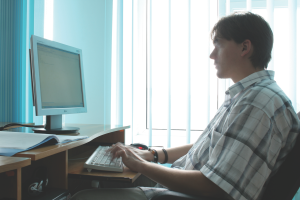 Most of us strain our upper backs habitually. Whether we’re slumping forward with our shoulders and head, or exaggeratedly pulling our shoulders back, we irritate the rhomboid attachments in the thoracic spine (upper back). The spinal muscles, either from being overstretched or overstrained, become “knotty” and sore.
Most of us strain our upper backs habitually. Whether we’re slumping forward with our shoulders and head, or exaggeratedly pulling our shoulders back, we irritate the rhomboid attachments in the thoracic spine (upper back). The spinal muscles, either from being overstretched or overstrained, become “knotty” and sore.
Additionally, to the extent that the upper back becomes stiff or even rigid from habitual hunching, it is challenging to stretch and mobilize the regions that most need attention. As with a rusty bicycle chain, stiff areas tend to remain stiff, and mobile areas compensate and become hypermobile.
If this description fits you, it may be time for a back roller (Gokhale Method approved!)
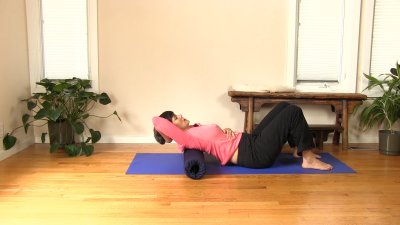 After years of experimenting with different types of rollers, I decided to design a roller after my own back. Here’s what I’ve come up with:
After years of experimenting with different types of rollers, I decided to design a roller after my own back. Here’s what I’ve come up with:
- An ideal roller needs to have a strong, hard core. There’s only so much give I want my roller to have. It’s the roller’s job to push back against my tight back and not bend out of shape (or worse, remain out of shape) when I lie on it.
- It needs to be comfortable, which means having a soft padded exterior. Pressure is good, but brutal pressure can bruise the back and feel plain uncomfortable, especially if you don’t have a lot of built-in padding.
- It needs to be at least one foot wide to support my torso, but not so wide that my hands won’t be able to reach the floor on either side of the roller when I roll / massage my sacrum.
- I would prefer for the material to not skid on my wooden floor or on my body. I used PU foam rather than EVA foam that most rollers are made from. EVA foam is too slippery. This means taking a small hit on how new the roller is going to look after use - well worth it in my view.
- I would prefer the roller to be light for travel. This means the hard inner core needs to be made of ABS rather than PVC tubing (the more common cheaper heavy material some rollers are made from)
- The central hard core should not slip out and crush my toes (been there, done that) when carrying the roller.
- I don’t want anything gimmicky like patterns on the roller - in my experience, little squares and rectangles carved into the roller’s surface don’t really translate into finger or thumb-type pressure but rather make for bumpy rolling.
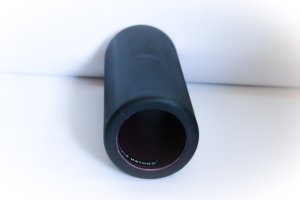
So there it is: ABS core (hard yet light), molded PU foam (soft but not too slippery), molded-over edges (prevents the core slipping out), one foot wide, plain exterior. It’s called the Gokhale Roller and we’re launching it today. We only have 1000 units - depending on your feedback, we will order more and make it a staple offering.
Directions:
- Sit on the floor with your knees bent. Place the foam roller behind you, perpendicular to your torso. Lie back on the foam roller. Adjust it so that the roller is even with your shoulder blades.
- Raise your butt up so that your weight is supported somewhat by your feet and mainly by the foam roller. Keep your elbows close together in front of your face. This gets your shoulder blades out of the way, exposing the tight muscles you really want to work. Move your hips up and down to roll along your upper back. You will notice that, to maximize your weight on the roller, your hips need to be elevated when you are working high up in the spine; when you are rolling your back lower in the thoracic area, the hips descend almost to the ground.
- While rolling out your back, your arms want to gently elongate your neck. At no point do the neck and back distort significantly from their original shape.
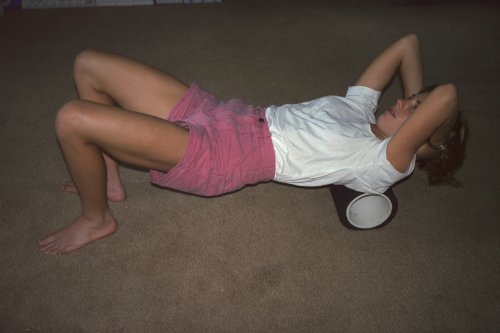
My student Merrill Page rolling out her upper thoracic spine.
Note her elbows ahead of her face and her arms gently elongating her neck.

Mid-back rolling
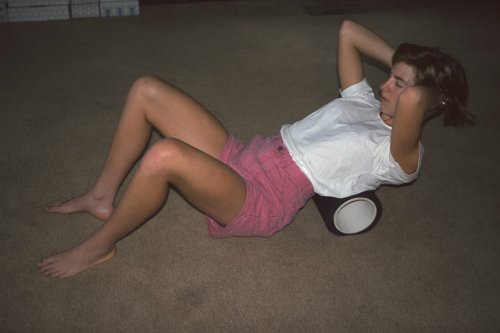
Rolling out the lower thoracic spine - note Merrill's bottom is almost on the ground.
The back and neck remain approximately the same shape throughout the exercise.
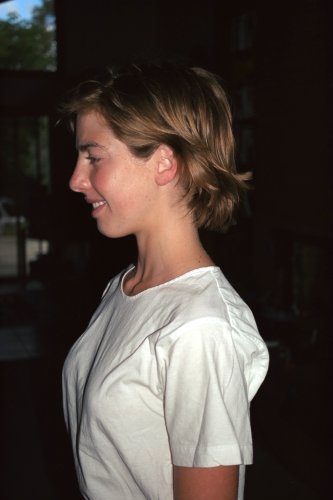
Back rolling helps keep your upper back upright and lovely!
Best,
Esther
Join us in an upcoming Free Workshop (online or in person).
Find a Foundations Course in your area to get the full training on the Gokhale Method!
We also offer in person or online Initial Consultations with any of our qualified Gokhale Method teachers.

Comments
Great post Esther. Assuming
Great post Esther.
Assuming I can ask you a question in this forum: if one uses a TallStanding posture, do you think that working at a standing desk for most of the work day is better or worse than using StackSitting and working at a sitting desk?
I ask because, like you, I had a herniated disk a few years ago, and used conventional treatment (before I heard of the Gokhale Method, which I now love!) and converted to a standing desk, and found that it was much more comfortable than sitting. I love the fact that you can get lots more small movements as you stand and work. In any case, I try to also sit for a couple of hours each day to rest my feet and legs.
Your thoughts are greatly appreciated, and thank you so very much for your hard work on developing the Gokhale Method, I think it is wonderful.
Tony
I recommend a combination of
I recommend a combination of stretchsitting, stacksitting, tallstanding, and moving (samba being my favorite standing desk movement), and letting your body, comfort, and the task at hand detemine the proportions. If done well, all of these positions / movements add value, and unless done to excess, don't have a significant downside in my opinion. I recommend focusing on improving your form in each of these techniques and then getting yourself to a level of health and equilibrium where you don't need an external rule to tell you what to do. Until you get to that point, though, use your intellect or an informed source to guide you as well - for example, if you've had a herniated disk, stretchsitting adds a lot of value to the mix as it resets your erector spinae (long back muscles) to a healthier baseline length. So add some stretchsitting if it feels good.
I prefer using a 12 inch ball
Comfort and your own agenda
Comfort and your own agenda trump everything - so if this suits you best, more power to you!
What I am seeking from a roller is a surface that mostly works "against" my stiffnesses and rigidities (for which I need a hard core) and only slightly molds to my body (to provide a modicum of comfort). For the tough "massage" I'm looking for, balls, or even rollers without a rigid core, are too squishy.
When it comes to my muscles in working with a roller, I want to be able to relax them as much as possible so my body can be well-worked. When it comes to looking for exercise, whether for my stabilizers or for other muscles, I look to other activities (dance motions are my personal favorite).
Estherbought the roller right
Esther
bought the roller right away
i am the one in Indy in November with the broken back--T 5,6,7
this roller has helped me ALOT
thankyouthankyou!!!!
e
love your work
Add New Comment
Login to add commment
Login